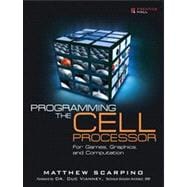
Matthew Scarpino lives in the San Francisco Bay area and develops software to interface embedded devices. He holds a masters in electrical engineering and has spent more than a decade in software development. His experience encompasses computing clusters, digital signal processors, microcontrollers, and field programmable gate arrays, but he loves programming the Cell processor most of all.
| Foreword | p. xv |
| Preface | p. xvii |
| Introducing the Cell Processor | p. 1 |
| The Software Development Tools | p. 13 |
| The Cell Software Development Kit (SDK) | p. 15 |
| Building Applications for the Cell Processor | p. 35 |
| Debugging and Simulating Applications | p. 53 |
| The Cell SDK Integrated Development Environment | p. 83 |
| The PowerPC Processor Element (PPE) | p. 97 |
| Introducing the PowerPC Processor Unit (PPU) | p. 99 |
| The SPE Runtime Management Library (libspe) | p. 125 |
| SIMD Programming on the PPU, Part 1: Vector Libraries and Functions | p. 153 |
| SIMD Programming on the PPU, Part 2: Methods and Algorithms | p. 195 |
| Part III | p. 217 |
| Introducing the Synergistic Processor Unit (SPU) | p. 219 |
| SIMD Programming on the SPU | p. 239 |
| SPU Communication, Part 1: Direct Memory Access (DMA) | p. 285 |
| SPU Communication, Part 2: Events, Signals, and Mailboxes | p. 317 |
| Advanced SPU Topics: Overlays, Software Caching, and SPU Isolation | p. 345 |
| SPU Assembly Language | p. 367 |
| Mathematics and Computation | p. 409 |
| Chapter 16 | p. 411 |
| Chapter 17 | p. 439 |
| Chapter 18 | p. 463 |
| Graphics and Games | p. 489 |
| Programming the Frame Buffer: Linux and the Play Station 3 | p. 491 |
| OpenGL on the Cell: Gallium and Mesa | p. 503 |
| Building Games with Ogre3D | p. 529 |
| Packaging Graphics with COLLADA | p. 559 |
| Epilogue | p. 581 |
| Appendices | p. 583 |
| Understanding ELF Files | p. 585 |
| Updating the PS3 Add-On Packages and Installing a New Linux Kernel | p. 609 |
| The Accelerated Library Framework (ALF) | p. 617 |
| SPU Instruction Set Reference | p. 649 |
| A Brief Introduction to Tcl | p. 661 |
| Index | p. 669 |
| Table of Contents provided by Publisher. All Rights Reserved. |
The New copy of this book will include any supplemental materials advertised. Please check the title of the book to determine if it should include any access cards, study guides, lab manuals, CDs, etc.
The Used, Rental and eBook copies of this book are not guaranteed to include any supplemental materials. Typically, only the book itself is included. This is true even if the title states it includes any access cards, study guides, lab manuals, CDs, etc.